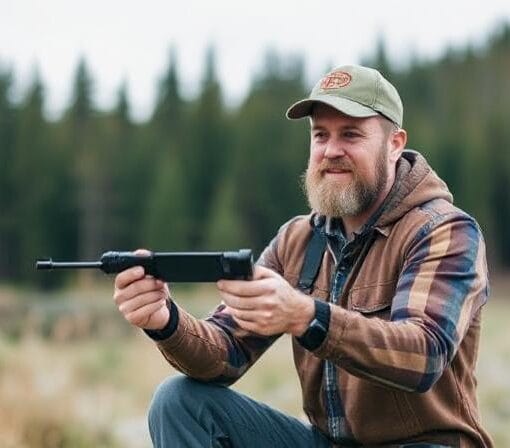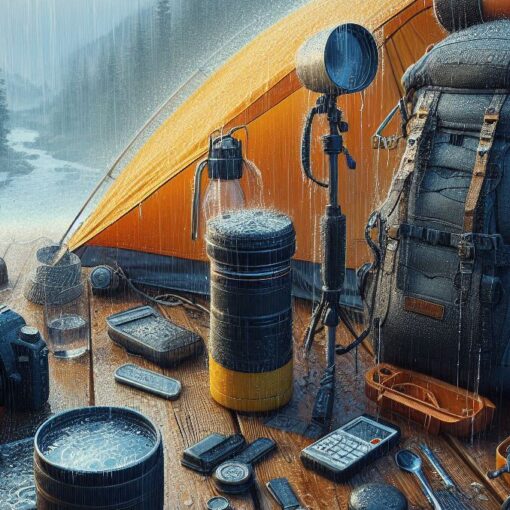Please Note: This post may contain affiliate links. If you click one of them, we may receive a commission at no extra cost to you. As an Amazon Associate, I earn from qualifying purchases.
Top Takeaways and Key Concepts
- Carry a map and compass as backup navigation tools when technology fails.
- Learn to read topographic maps using contour lines, symbols, and terrain features.
- Use a compass correctly by aligning it flat and following magnetic north.
- Combine map and compass to plot bearings and triangulate your exact location.
- Practice navigation skills regularly to build confidence and avoid getting lost outdoors.
Summary of This Article
This article explains how traditional navigation tools like maps and compasses can keep you safe and confident outdoors when GPS fails. It covers how to read topographic maps, follow compass directions, and combine both tools to stay on course. It also encourages staying calm, using natural landmarks, taking notes along the way, and practicing navigation regularly. With the right mindset and simple techniques, anyone can explore safely and enjoy wilderness adventures without fear of getting lost.
Short Video Version of this Article
Ah, the wonderful outdoors! Isn’t it so pretty and peaceful? But occasionally it can make us feel a little… um, hesitant.
You are in a place with big trees and birds singing, and suddenly you look at your phone. Oh no! The battery is dead. Panic starts to set in. Apps that use GPS? Who would have believed it would be useless without a signal? But don’t worry!
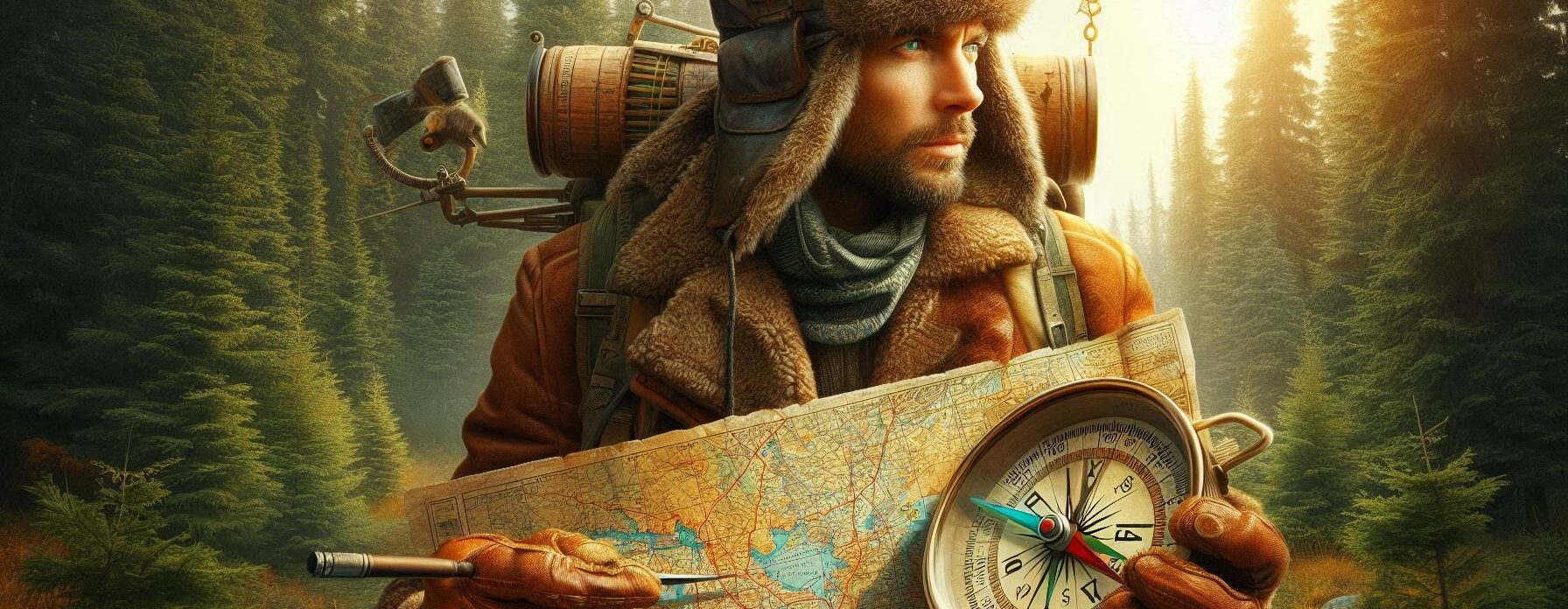
A good map and compass can definitely help you out. You can think of it as a treasure hunt. Also, bringing some snacks can provide you energy while you explore. When you’re lost, nothing lifts your spirits like a nutty granola bar.
Now, let’s talk about some amusing tips. First, find that huge old map, maybe one of those paper ones from back in the day. They don’t need to be charged! Learn how to read it; it’s like a secret guidebook that shows you where rivers and trails are. And what about the compass? It seems like magic. North, south, east, and west will all help you figure out where to go.
Stay calm if you feel lost. Breathe deeply. Pay attention to what’s around you. Can you see any rivers or mountains? They make fantastic markers. After you find them, you can decide where to go next. Believe me, it’s like going on your own personal journey.
Bring your map and compass with you the next time you go outside. And don’t forget to pack some munchies! Take in the beauty and a little bit of mystery. You are now a modern explorer, looking for your next fantastic story.
Understanding Your Map
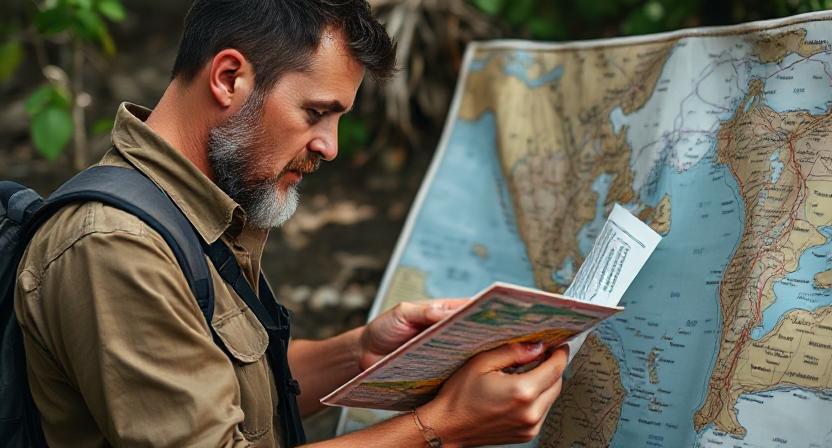
Let’s talk about maps. No, not those crumpled ones from 1997 that still smell faintly of mildew; I mean actual topographic maps that show elevation changes, trails, and other vital information. If reading a map feels like deciphering hieroglyphics, don’t worry—you’re not alone!
A good map will have symbols representing different features like rivers (which are typically blue), trails (often dashed lines), and campgrounds (which may look suspiciously like tiny tents).
Did you know that those wiggly lines on a map are called contour lines? They show how high or low the land is. When those lines are squished together, it means the ground is steep. Perfect if you’re practicing for a big hiking event, right?
Getting the hang of reading maps can be super fun. First, look around you. Check for things that stand out. Is there a big rock? Maybe some tall trees? If that giant rock on your left is labeled “Big Rock,” well, look at you! You’ve just found your spot on the map. No need to shout for help.
Once you know where you are, you can figure out where to go next. It’s like being a treasure hunter!
If you see that the lines are far apart, the ground is flat. Great for a nice, easy walk. But if they’re all scrunched up? Get ready for a workout!
So, grab your map, look around, and have fun exploring. You got this! And hey, remember to celebrate those little wins. Finding your place can feel like a big victory.
The Magic of the Compass
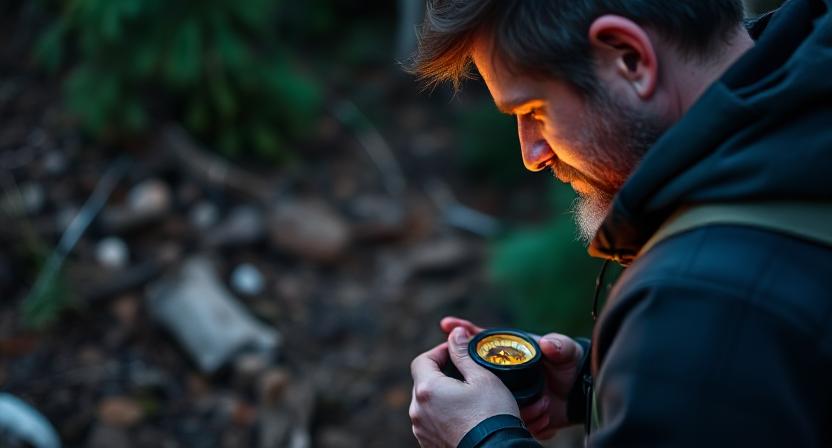
Now let’s talk about our next hero: the compass. This tiny gadget may seem simple, but believe me, it’s smarter than it looks. The baseplate (the clear plastic piece), the magnetic needle (the pointy part that spins), the direction-of-travel arrow (the one pointing straight ahead), and the degrees marked along the edge are the four primary parts of a compass.
Here’s a fun fact: compasses don’t point to real north; they point to magnetic north. If someone tells you to “just follow north,” you may grin and gently remind them. We don’t want to end up at Aunt Edna’s house instead of Camp Wilderness, do we?
Once you know the secret, it’s really easy to use a compass. Put it flat in front of you. Very flat, like. Next, move your complete body so that the needle points to the “N” on the compass. Simple as pie!
And look at you, now you’re looking north! Or really close! I mean, who will care if you’re a little off? Just don’t travel too far away.
You get better every time you utilize it. It’s nice to know that you can find your way. Doesn’t it make you feel like a superhero?
So the next time you go out to explore, take that compass. Get ready for an adventure. It’s all part of the fun! Just keep in mind that even a small mistake can take you to unexpected destinations. It might not be so horrible to live in Aunt Edna’s house after all!
Combining Map and Compass Skills
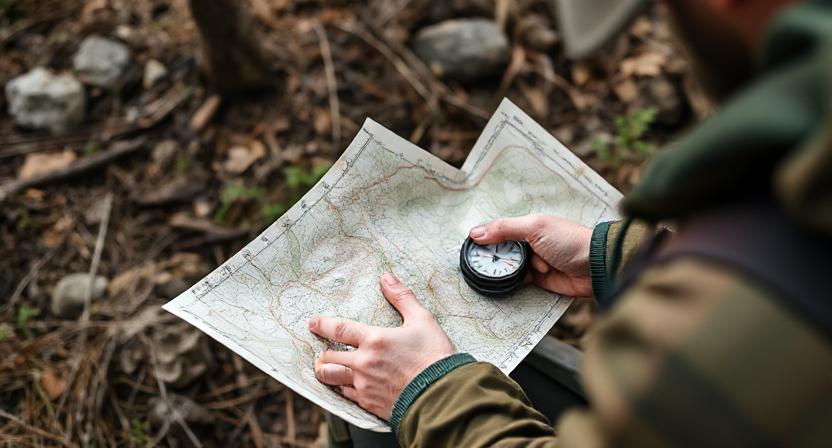
Now comes my favorite part: putting these two tools together to make an unstoppable navigation pair! It may sound hard, but it’s like making peanut butter and jelly sandwiches—easy once you know how.
Let’s get going! You need to line up your compass and map first. Check to see that they both point north. It’s like getting ready for a great game. Choose a place you wish to go after that. How about a nice lake? Make a straight line from where you are to the lake. You can use a pencil or even a stick if you want to. Isn’t it kind of cool?
Now it’s time for the exciting part: triangulation! Doesn’t that sound fancy? But it’s actually just a smart approach to find out where you are by leveraging items around you. Find three points of interest. It could be a mountain, a tall tree, or a rock that looks odd. Get out your compass and figure out what their angles are. Point it at each landmark and jot down the numbers.
When do all three angles meet? Boom! You discovered your place like a pro! You don’t need Google Maps this time. You, your compass, and nature.
You know, there’s something unique about finding your way this way. It’s like being a small adventurer. Do you ever feel that thrill when everything falls into place? That’s the finest part. And if you get lost, that’s all part of the fun! Just keep going. You won’t have any trouble with it.
Staying Found While Adventuring

Let’s face it; even seasoned explorers can get lost sometimes (I know I have!). To minimize confusion while navigating through dense forests or rocky terrains:
Writing things down is quite helpful! Just small things, like making a note of big rocks or paths that look unusual. If you have to come back, it won’t feel like attempting to figure out a weird puzzle in the dark. That’s not fun at all.
Along the route, look for interesting places. A big tree that looks like an octopus? Yes, please! Or a rock that makes you think of a movie star? Great! Those cool locations are like friendly signs that show you the way home. It’s like having your own map to find riches.
It’s also important to stay calm. Take a few deep breaths if you feel lost. When you think about how many squirrels might be observing you from above, it can seem like a lot. Just pay attention. Squirrels are probably more interested in their acorns anyway.
It takes practice to get adept at staying found. But once you get the hang of it, you’ll be the hero of the day and impress your pals with how good you are. And no more strange detours that feel like a maze! Don’t forget that the journey is what matters, even when it becomes hard.
Tips for Modern Explorers
In today’s world filled with technology distractions—even during camping trips—it’s crucial to embrace traditional navigation methods alongside modern gadgets:
It’s great to practice often! Before you go to those very far-off regions where you can’t even get a signal, practice with maps and compasses where you reside. It’s like a fun treasure hunt that you do over and over until you get good at it.
It can be quite rewarding to teach others, too! Tell your pals what you’ve learnt. It might make them curious. You never know; someone might think that being lost is just who they are. They might end up loving navigation and going on new adventures!
Don’t forget the reason we go outside. Isn’t it all about having fun in nature? Take in the beautiful vistas and listen to the birds. Stop worrying about which way is east. Take a deep breath of fresh air and appreciate the moment.
Adding these tips to your excursions makes them more fun. You might soon be one of the best navigators nature has ever seen! That’s quite cool, isn’t it? You’ll make every journey memorable, and you’ll learn and laugh together the whole time.
Featured Snippet: Learning to navigate with a map and compass is a valuable outdoor survival skill that builds confidence and safety when technology fails. By understanding topographic maps, using a compass correctly, and practicing triangulation, anyone can stay on course and avoid getting lost on outdoor adventures.
Frequently Asked Questions
Why should I carry a map and compass if I already have GPS?
GPS can fail due to dead batteries, weak signals, or weather interference, but a map and compass always work and provide reliable navigation backup.
What is the best type of map for outdoor navigation?
A topographic map is best because it shows terrain features like elevation, rivers, and trails, helping you navigate with accuracy.
How do I read contour lines on a map?
Contour lines show elevation; lines close together indicate steep terrain, while lines farther apart represent flatter ground.
What is magnetic north and why does it matter?
Magnetic north is the direction a compass points, and it differs from true north, so navigation requires adjusting for this difference in some regions.
How do I combine a map and compass for navigation?
You align the map to north, plot a bearing with the compass, and follow that direction to reach your destination.
What is triangulation in navigation?
Triangulation is a method of finding your exact location by taking bearings from two or more known landmarks using a compass.
How can I improve my navigation skills?
Practice regularly in familiar areas, take short navigation hikes, and challenge yourself to navigate without relying on digital tools.
Suggested Resources:
Outdoor Navigation Basics
https://www.rei.com/learn/expert-advice/navigation-basics.html
Understanding Topographic Maps
https://www.fs.usda.gov/t-d/pubs/htmlpubs/htm09732802/page01.htm
Using a Compass Effectively
https://www.wikihow.com/Use-a-Compass

Kevin Collier is a seasoned outdoor enthusiast and writer for Trekbug.com, specializing in outdoor adventures, survival strategies, and prepping insights. With a deep love for nature and a commitment to self-sufficiency, Kevin empowers readers to embrace the wilderness confidently. He shares valuable tips, practical techniques, and inspiring stories, helping both novice and experienced adventurers develop essential skills for surviving and thriving in the great outdoors.


